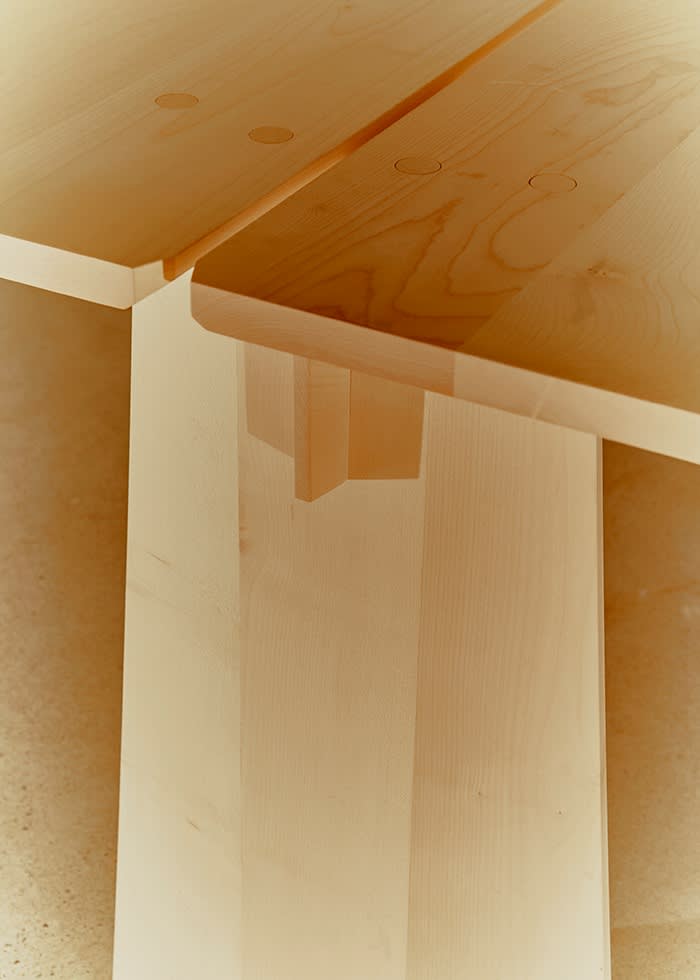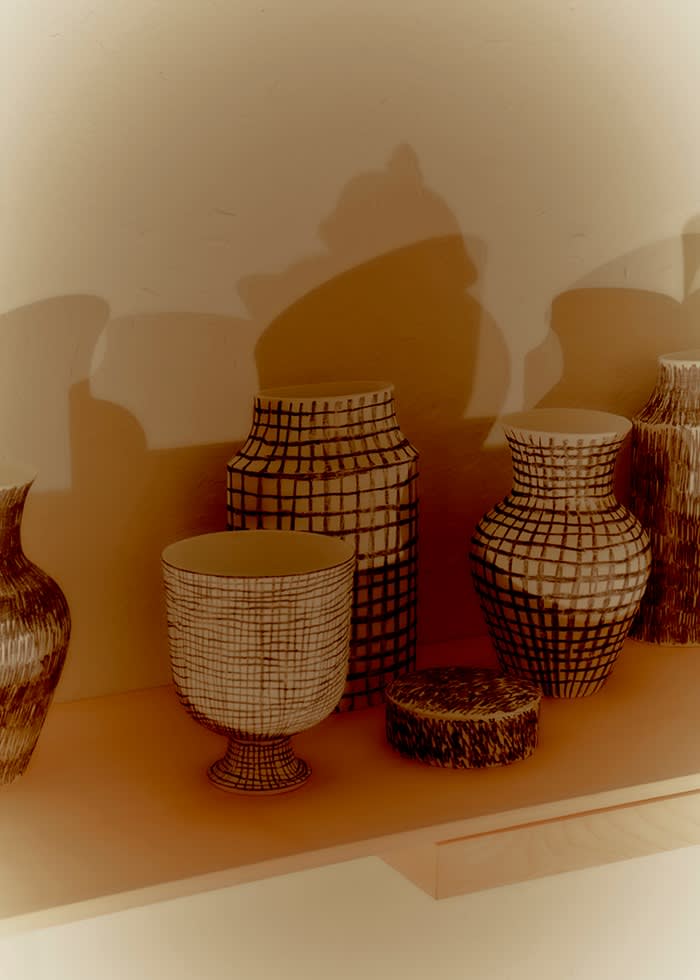On an unusually cold day in May, Andrea Trimarchi and Simone Farresin are trampling across a large, man-made clearing in the forests of southern Finland, near the Baltic city of Turku. This stark landscape is the result of clear-cutting: swathes of woodland sliced down for timber production, decimating the habitats of the flora and fauna living there. It’s quiet, almost eerily so, with barely a bird song breaking the silence.
The two Italian designers, partners in life and work, are collectively known by their studio name of Formafantasma, which produces exquisite furniture, vessels and films. They are passionate environmentalists and aim to expose and reconfigure harmful practices in which the design industry is complicit.
Since founding Formafantasma in 2009, the Milan-based duo has been digging into some of our most extractive industries, from timber to electronics. They have, for example, roamed forests and visited factories across Europe as part of their ongoing investigation into the governance of the timber industry, which, according to the World Wildlife Fund, generates $186bn worldwide and has an enormous environmental impact. The men, who describe Formafantasma as “a research-based design studio”, want to find out how design can quell overconsumption of materials, like wood, which make up the background matter of our lives.
Trimarchi, 38, and Farresin, 41, are in Finland at the invitation of Artek, a Finnish company known for its curvaceous birchwood furniture, synonymous with Nordic minimalism, and for whom they plan to produce a future collection. Formafantasma is probing the inner workings of Finnish forestry, exploring the man-made plantations – usually monocultures – that dominate the landscape using infrared photography to capture details of the forest hidden from the human eye.
They are both impeccably groomed (Farresin wears Calvin Klein trousers beneath his thick Patagonia outerwear). Despite their attire, the designers like to get their hands dirty.
Their first investigation into the forestry industry was commissioned by London’s Serpentine Galleries for an exhibition in 2020. It was called Cambio (“change” in Italian) and, among video interviews with experts, there was an animation of a tree addressing the human race. Elsewhere in the gallery, there was a cluster of seemingly innocuous everyday objects: a hammer, a ping-pong paddle and lumps of barbecue charcoal. Text beneath highlighted how the manufacturers had mis-declared some of the types of wood used, revealing that endangered species were still being used to make cheap, disposable products.
As a result of that show, Artek is now funding an expansion of Cambio in Finland, a country in which 73 per cent of the landmass is covered by forests. Artek is heavily reliant on Finnish wood; Formafantasma hopes it can help the company influence how these forests are managed in the future.
Trimarchi and Farresin are gazing at the landscape through an infrared lens that is often used in forestry to detect plant variety, vigour and stress – in other words, how healthy the forest is. In their cinematic art piece, shot in various forests in Finland, the infrared lens will make the trees and dismembered stumps glow in shades of orange or purple, depending on their wellbeing.

Its chromatic beauty will be layered with a message about the biodiversity perils of clear-cutting, a technique still prevalent across the Nordics. It is also a nod to “plant blindness”, how the human eye evolved to ignore plant species, focusing on predators or prey instead.
The designers want us to see forests with fresh eyes and with new empathy. “In the film, the forest will never be the background – it’s the focus,” says Farresin. He and Trimarchi are not blind to the vital role that timber plays in the Finnish economy, however. “When the country gained independence from Russia, the forest helped Finland survive. We’re not against using timber in products, we just want to give information. And as designers, we’re the trees’ first clients.”
Formafantasma’s light-filled studio in Milan is also a temporary home. It is situated within the cultural complex Assab One, a converted print factory in the Via Padova neighbourhood, an unpolished part of town, away from design’s traditional stomping ground.
“We’re not interested in belonging to a design scene; we want to remain literally on the edge,” says Farresin, now back from Finland. “We need to open a conversation about design that goes wider than national boundaries. When you start looking at ‘Italian design’, the realities are more complex than well-shaped chairs.”
Today, Trimarchi and Farresin, born in Sicily and Vicenza respectively, are wearing sharp, monochrome outfits that complement the clean lines of their studio and their immaculate desks. They moved back to Milan recently, after 14 years in the Netherlands. “We never learnt Dutch, and the longer we stayed, the more we were turning into an Italian cliché,” Farresin tells me. He is the bigger talker of the two. Trimarchi is “the decisive one”.
They are bringing some of their research from the Artek-commissioned iteration of Cambio to Milan design week as part of a three-day symposium they are curating called Prada Frames: On Forest (6-8 June), with the Milanese fashion house. The symposium, which will be free and open to all at the Braidense National Library in the central neighbourhood of Brera, will draw together the worlds of design, science, conservation, engineering and policymaking to explore ecology from all angles. A few days later, their exhibition Cambio will open at the Design Museum Helsinki, where their film will be shown.
Formafantasma has a busy few weeks ahead: during Milan design week, design house Maison Matisse will launch a new series of lights created by the pair and inspired by the French artist Henri Matisse’s paper cut-outs. Furniture brand Cassina and tableware specialist Ginori 1735 will debut their collection of porcelain vessels, adorned with hand-painted graffiti in ceramic chalk.
When we meet, Trimarchi and Farresin are also writing a manifesto on sustainable exhibition-making to be presented this month at the London Serpentine Galleries’ show Back to Earth. They will be putting some of its principles into practice in their scenography for the Triennale Milano’s Mondo Reale art show (opening in July). Next they begin a deep dive into the wool industry for the newly opened National Museum of Oslo.
It’s all part of Formafantasma’s mission to show that design is much more than a styling tool, that it can change entire systems. The Prada Frames symposium is a counterpoint to all the newness at the Salone del Mobile, and a chance to question what the term “sustainable” really means. “It’s important to offer content, not just products during the world’s biggest furniture fair,” says Trimarchi.
Among the speakers at Prada Frames, Valerie Trouet will discuss the science of dendroclimatogy, which uses tree rings to show how climates have changed; anthropologist Anna Tsing will address the need to adopt an “interspecies” perspective; and Niklas Kaskeala of carbon-offsetting company Compensate will delve into the complexities of his field. It’s a concept that troubles Formafantasma. “To us, the idea of emitting carbon in one place, then offsetting it by planting trees in another part of the world is problematic,” says Farresin. “Who’s managing those forests and on what land? Wouldn’t it be better to focus on protecting Europe’s remaining primary forest? We like the fact that Niklas isn’t afraid to criticise it.”
As we chat, they are still finalising the speakers. Given that indigenous communities are the caretakers of most of the world’s remaining primary forests, one hopes to find representatives in the final line-up. For Formafantasma, the symposium and the broader Cambio project is a way to disrupt the myth that a single design hero will save the day. “It’s so romantic and self-indulgent,” says Trimarchi.
The pair met at design school in Florence and have worked together as a team ever since they enrolled on their Masters at Design Academy Eindhoven in the Netherlands. “People thought it was a radical idea to sign up as a team, but they didn’t realise we came from a school where many designers in the 1970s worked in groups, such as the architecture firm Superstudio.” Operating together helps them externalise and challenge their ideas, they say, and while they rarely work with other creatives, they regularly tap experts for research projects.

Such collaboration is essential in the fight against climate change, write MoMA curator Paola Antonelli and design critic Alice Rawsthorn in their new book Design Emergency: Building a Better Future. Formafantasma is among the designers, architects, engineers, artists, scientists and activists who Antonelli and Rawsthorn believe are harnessing design thinking to effect far-reaching change. “Andrea and Simone are part of a group who are using their skills to explore a dark web of interconnecting systems,” Antonelli tells me later. “But they have a sympathetic attitude towards the challenges and to other species, beyond just humans.”
Formafantasma has always revelled in material research. One of its first projects to gain attention was the 2011 Botanica collection of vessels, currently on show in the sleek surrounds of mid-century industrial designer Russel Wright’s home Manitoga in Garrison, New York. The series imagines that the oil industry never existed, harking back to the 18th and 19th centuries, when botanists made plastic-like materials from extracts of plants and animal derivatives.
Since then, they have crafted furniture from lava, conducted a two-year research into electronic waste (named Ore Streams) and worked with many of the design industry’s big players, including Italian lighting manufacturer Flos and fashion house Fendi.
The pair have been criticised in the past for distilling complex environmental ideas into luxury furniture. Wouldn’t their message hit harder if it could reach more homes?

“You don’t have to own an idea for it to make an impact on you,” says Farresin. Trimarchi chips in: “Ultimately, we’re a commercial studio and we make objects that seduce, but when you look closely, there’s always a detail that breaks the pristineness and makes you question what’s going on, like the pile of cell phone shells holding up the legs of one of our Ore Streams tables.”
While their products aren’t accessible to everyone, their research is. The Cambio research, for example, will also be used by students on the new GEO-Design Masters programme, which the designers devised and now teach at their alma mater, the Design Academy Eindhoven. The aim is to encourage a new generation of design interrogators.
Formafantasma’s future plan is to focus on long-term collaborations. “A throwaway relationship can lead to a throwaway product,” explains Farresin. “You need time to understand a company’s needs and how design can encourage responsible practices.”
Artek, for instance, gave them six months to speak to its staff, as well as consulting with politicians, ecologists and paper manufacturers. “Not many furniture companies would allow you to do that,” Farresin explains. “In recent decades, research and development has been pretty thin.”

While delving into Artek’s collections, they found an exception to their almost exclusively birch furniture: a rippling pine room divider, by Finnish design giant Alvar Aalto in 1936. In the Design Museum Helsinki show this month, they will place this iconic piece alongside a pile of packaging and wooden pallets: throwaway items also made from pine. If these disposable items were trashed and incinerated, it would take 51 years for one pine tree to reabsorb the carbon dioxide released, a sign next to it will state. The message is clear: a design classic that you pass down the generations can store carbon for centuries.
What Formafantasma wants us to grasp is that furniture made from natural, renewable materials isn’t necessarily squeaky clean. These materials could be grown and gathered in ways that contribute to environmental degradation. When Trimarchi and Farresin create their own design hits for Artek in the years to come, they will be made with the health and wellbeing of Finland’s forests in mind.
Follow @FTMag on Twitter to find out about our latest stories first
https://www.ft.com/content/af36ad28-d2d1-4a21-8407-91fc39fd4364

